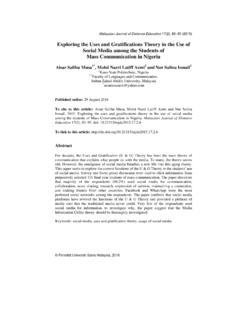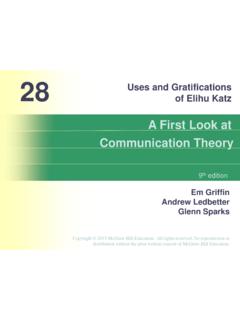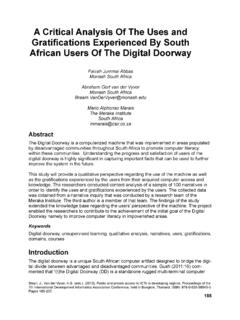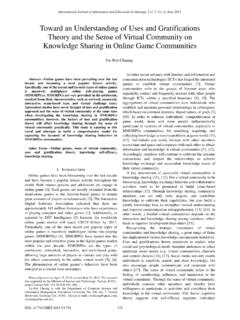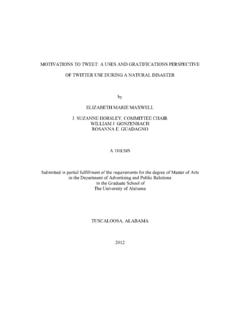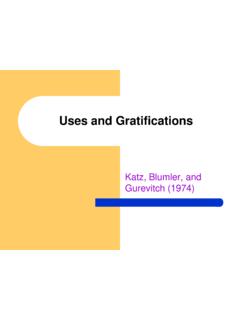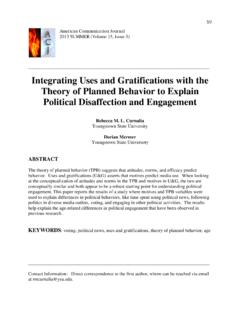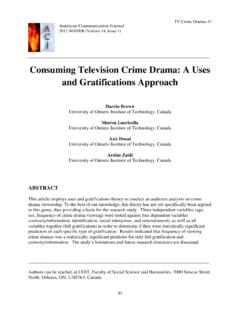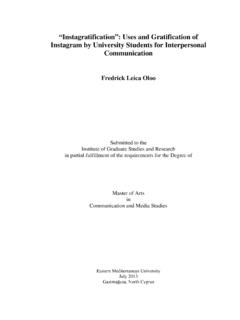Transcription of Uses and Gratifications Theory in the 21st Century
1 uses and Gratifications Theoryin the 21st CenturyThomas E. RuggieroCommunications DepartmentUniversity of Texas at El PasoSome mass communications scholars have contended that uses and Gratifications isnot a rigorous social science Theory . In this article, I argue just the opposite, and anyattempt to speculate on the future direction of mass communication Theory must seri-ously include the uses and Gratifications approach. In this article, I assert that theemergence of computer-mediated communication has revived the significance of usesand Gratifications . In fact, uses and Gratifications has always provided a cutting-edgetheoretical approach in the initial stages of each new mass communications medium:newspapers, radio and television, and now the Internet.
2 Although scientists are likelyto continue using traditional tools and typologies to answer questions about mediause, we must also be prepared to expand our current theoretical models of uses andgratifications. Contemporary and future models must include concepts such asinteractivity, demassification, hypertextuality, and asynchroneity. Researchers mustalso be willing to explore interpersonal and qualitative aspects of mediated commu-nication in a more holistic mass communication scholars today refer to as theuses and Gratifications (U&G)approachis generally recognized to be a subtradition of media effects re-search (McQuail, 1994).
3 Early in the history of communications research, an ap-proach was developed to study the Gratifications that attract and hold audiences tothe kinds of media and the types of content that satisfy their social and psychologi-cal needs (Cantril, 1942). Much early effects research adopted the experimental orquasi-experimental approach, in which communication conditions were manipu-lated in search of general lessons about how better to communicate, or about the un-intended consequences of messages (Klapper, 1960).MASS COMMUNICATION & SOCIETY, 2000,3(1), 3 37 Requests for reprints should be sent to Tom Ruggiero, Print Journalism, 102 B Cotton MemorialCommunication Department, University of Texas, El Paso, TX 79968.
4 E-mail: media effects research sought to discover motives and selection patternsof audiences for the new mass media. Examples include Cantril and Allport (1935)on the radio audience; Waples, Berelson, and Bradshaw (1940) on reading; Herzog(1940, 1944) on quiz programs and the Gratifications from radio daytime serials;Suchman (1942) on the motives for listening to serious music; Wolfe and Fiske(1949) on children s interest in comics; Berelson (1949) on the functions of news-paper reading; and Lazarsfeld and Stanton (1942, 1944, 1949) on different mediagenres. Each of these studies formulated a list of functions served either by somespecific content or by the medium itself:To match one s wits against others, to get information and advice for daily living, toprovide a framework for one s day, to prepare oneself culturally for the demands ofupward mobility, or to be reassured about the dignity and usefulness of one s role.
5 (Katz, Blumler, & Gurevitch, 1974, p. 20)This latter focus of research, conducted in a social-psychological mode, and audi-ence based, crystallized into the U&G approach (McQuail, 1994).Some mass communication scholars cited moral panic and the Payne FundStudies as the progenitor of U&G Theory . Undertaken by the Motion PictureResearch Council, the Payne Fund Studies were carried out in the late sociologists and psychologists including Herbert Blumer, Philip Hauser,and L. L. Thurstone sought to understand how movie viewing was affecting theyouth of America (Lowery & DeFleur, 1983). Rosengren, Johnsson-Smaragdi, andSonesson (1994), however, argued that the Payne Fund Studies were primarily ef-fects-oriented propaganda studies, as opposed to the U&G tradition, which focuseson research of individual use of the media.
6 Likewise, Cantril s (1940) study ofOrson Welles s War of the Worlds radio broadcast was more narrowly interestedin sociological and psychological factors associated with panic behavior than in de-veloping a Theory about the effects of mass communication (Lowery & DeFleur,1983).Wimmer and Dominick (1994) proposed that U&G began in the 1940s when re-searchers became interested in why audiences engaged in various forms of mediabehavior, such as listening to the radio or reading the newspaper. Still others creditthe U&G perspective with Schramm s (1949) immediate reward and delayed re-ward model of media Gratifications (Dozier & Rice, 1984).
7 Regardless, early U&G studies were primarily descriptive, seeking to classifythe responses of audience members into meaningful categories (Berelson,Lazarsfeld, & McPhee, 1954; Katz & Lazarsfeld, 1955; Lazarsfeld, Berelson, &Gaudet, 1948; Merton, 1949).Most scholars agree that early research had little theoretical coherence and wasprimarily behaviorist and individualist in its methodological tendencies (McQuail,1994). The researchers shared a qualitative approach by attempting to group gratifi-4 RUGGIERO cation statements into labeled categories, largely ignoring their frequency distribu-tion in the population. The earliest researchers for the most part did not attempt toexplore the links between the Gratifications detected and the psychological or so-ciological origins of the needs satisfied.
8 They often failed to search for the interrela-tions among the various media functions, either quantitatively or conceptually, in amanner that might have led to the detection of the latent structure of media of early U&G research focus on the fact that it (a) relied heavily onself-reports, (b) was unsophisticated about the social origin of the needs that audi-ences bring to the media, (c) was too uncritical of the possible dysfunction both forself and society of certain kinds of audience satisfaction, and (d) was too captivatedby the inventive diversity of audiences used to pay attention to the constraints of thetext (Katz, 1987).
9 Despite severe limitations, early researchers, especially those atthe Bureau of Applied Social Research of Columbia University, persevered, partic-ularly in examining the effects of the mass media on political behavior. They stud-ied voters in Erie County, Ohio, during the 1940 election between Roosevelt andWilkie (Lazarsfeld et al., 1948) and voters in Elmira, New York, during the 1948 Truman Dewey election (Berelson et al., 1954). Both studies suggested that themass media played a weak role in election decisions compared with personal influ-ence and influence of other people. As a result, Berelson et al. began amplifying thetwo-step flow Theory , moving away from the concept of an atomized audienceand toward the impact of personal influence (Katz, 1960).
10 1950S AND 1960S RESEARCHD espite disagreement by communication scholars as to the precise roots of the ap-proach, in the next phase of U&G research, during the 1950s and 1960s, researchersidentified and operationalized many social and psychological variables that werepresumed to be the precursors of different patterns of consumption of Gratifications (Wimmer & Dominick, 1994). Accordingly, Schramm, Lyle, and Parker (1961)concluded that children s use of television was influenced by individual mentalability and relationships with parents and peers. Katz and Foulkes (1962) conceptu-alized mass media use as escape. Klapper (1963) stressed the importance of analyz-ing the consequences of use rather than simply labeling the use as earlier research-ers had done.
